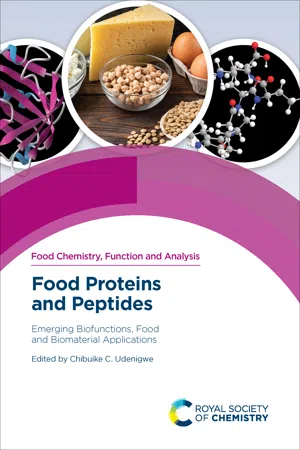
Food Proteins and Peptides
Emerging Biofunctions, Food and Biomaterial Applications
- 506 pages
- English
- ePUB (mobile friendly)
- Available on iOS & Android
Food Proteins and Peptides
Emerging Biofunctions, Food and Biomaterial Applications
About this book
This book discusses the chemistry of food proteins and peptides and their relationship with nutritional, functional, and health applications.
Bringing together authorities in the field, it provides a comprehensive discussion focused on fundamental chemistries and mechanisms underpinning the structure-function relationships of food proteins and peptides. The functional and bioactive properties hinge on their structural features such as amino acid sequence, molecular size, hydrophobicity, hydrophilicity, and net charges. The book includes coverage of advances in the nutritional and health applications of protein and peptide modifications; novel applications of food proteins and peptides in the development of edible functional biomaterials; advances in the use of proteomics and peptidomics for food proteins and peptide analysis (foodomics); and the relevance of food protein and peptide chemistries in policy and regulation.
Research into the fundamental chemistries behind the functional, health and nutritional benefits is burgeoning and has gained the interest of scientists, the industry, regulatory agencies, and consumers. This book fills the knowledge gap providing an excellent source of information for researchers, instructors, students, food and nutrition industry, and policy makers.
Frequently asked questions
- Essential is ideal for learners and professionals who enjoy exploring a wide range of subjects. Access the Essential Library with 800,000+ trusted titles and best-sellers across business, personal growth, and the humanities. Includes unlimited reading time and Standard Read Aloud voice.
- Complete: Perfect for advanced learners and researchers needing full, unrestricted access. Unlock 1.4M+ books across hundreds of subjects, including academic and specialized titles. The Complete Plan also includes advanced features like Premium Read Aloud and Research Assistant.
Please note we cannot support devices running on iOS 13 and Android 7 or earlier. Learn more about using the app.
Information
*E-mail: [email protected]
The structure of food proteins influences their function and hence their use in developing food products. Researchers have frequently employed enzymes to modify and study protein techno-functionality under different conditions and to enhance the biological functions or health-promoting properties of proteins. As more people continue to show interest not only in the nutritive aspect of food proteins but also in the sustainability of food processing and product development methods, there has been a growing effort by researchers and the food industry to provide food protein products that are consistent with the expectations of today's consumers. Not only is the use of green processing methods such as supercritical fluid extrusion, ohmic heating, pulsed electric field and high hydrostatic pressure on the increase, there is also heightened interest in innovative high-tech strategies for food delivery and controlled nutrient release such as micro- and nanoencapsulation. This chapter reviews the various sources of food proteins, including non-traditional sources such as algae and insects, the effects of various processing methods on food protein structure and functionality, novel delivery systems and technologies in food protein product development and the growing impact of consumers on product development, including the increasing consumption of and even preference for plant-based meat alternatives. It is concluded that although there are promising signs of increased use of sustainable processing methods and seemingly endless possibilities in the development of new food protein products, there are also challenges such as the microbiological and allergenic risks inherent in using members of the class Insecta for food.
1.1 Introduction
1.2 Sources of Food Proteins
1.2.1 Plants
1.2.2 Animals
1.2.3 Insects
Table of contents
- Cover
- HalfTitle
- Series
- Title
- Copyright
- Preface
- Contents
- Chapter 1 Food Protein Structures, Functionality and Product Development
- Chapter 2 Research Advances in Food Protein Digestibility
- Chapter 3 Food Protein Allergenicity: Characterization, Epitope Mapping and Deactivation
- Chapter 4 Food Proteins as Biomaterial for Delivery Functions
- Chapter 5 Controlled Protein-based Aggregates as Interfacial Stabilizers: Fabrication, Mechanism and Potential Application as Food Ingredients
- Chapter 6 Chemistry and Functional Roles of Food Protein Hydrogels
- Chapter 7 Protein-based Bioplastics for Food and Pharmaceutical Packaging
- Chapter 8 Protein Modifications and the Food Matrix: Consequences, Chemistry and Characterization
- Chapter 9 Therapeutic Protein Production from Genetically Modified Foods
- Chapter 10 Stability of Bioactive Peptides During Processing
- Chapter 11 Transport, Cellular Uptake and Bioavailability of Food Peptides
- Chapter 12 Food-derived Peptides in Lipid Metabolism
- Chapter 13 Food Peptides in Energy Metabolism
- Chapter 14 Food Proteins in Controlling Satiety
- Chapter 15 Food Peptides in Blood Pressure Regulation
- Chapter 16 Chemistry and Function of Antimicrobial Peptides
- Chapter 17 Advances in the Use of Bioinformatics to Discover Biofunctional Food Peptides
- Chapter 18 Chemistry and Biological Mechanisms of Peptides That Modulate Taste
- Chapter 19 Omics Approach to Understanding the Distribution of Food Peptides in Food and Biological Samples
- Subject Index